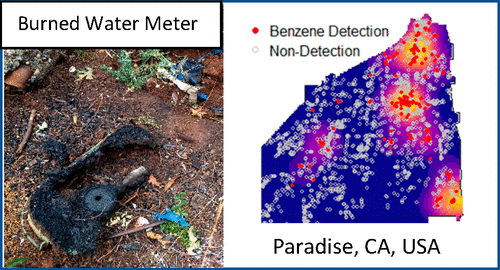当前位置:
X-MOL 学术
›
ACS ES&T Water
›
论文详情
Our official English website, www.x-mol.net, welcomes your
feedback! (Note: you will need to create a separate account there.)
Fire and Water: Assessing Drinking Water Contamination After a Major Wildfire
ACS ES&T Water ( IF 4.8 ) Pub Date : 2021-08-02 , DOI: 10.1021/acsestwater.1c00129 Gina M Solomon 1 , Susan Hurley 2 , Catherine Carpenter 3 , Thomas M Young 4 , Paul English 3 , Peggy Reynolds 2
ACS ES&T Water ( IF 4.8 ) Pub Date : 2021-08-02 , DOI: 10.1021/acsestwater.1c00129 Gina M Solomon 1 , Susan Hurley 2 , Catherine Carpenter 3 , Thomas M Young 4 , Paul English 3 , Peggy Reynolds 2
Affiliation

|
We investigated patterns of volatile organic compound (VOC) contamination in drinking water systems affected by the California 2018 Camp Fire. We performed spatial analysis of over 5000 water samples collected over a 17 month period by a local water utility, sampled tap water for VOCs in approximately 10% (N = 136) of standing homes, and conducted additional nontargeted chemical analysis of 10 samples. Benzene contamination was present in 29% of service connections to destroyed structures and 2% of service connections to standing homes. A spatial pattern was apparent. Tap water in standing homes 11 months after the fire contained low concentrations of benzene in 1% of samples, but methylene chloride was present in 19% of samples, including several above regulatory limits. Elevated methylene chloride was associated with greater distance from the water meter to the tap, longer stagnation time, and the presence of a destroyed structure on the service connection; it was inversely associated with certain trihalomethanes. Nontargeted analysis identified multiple combustion byproducts in the water at 2/10 homes. Our findings support the hypothesis that pyrolysis and smoke intrusion from depressurization contributed to the benzene contamination. Further research is needed to test the hypothesis that methylene chloride may be generated from the dehalogenation of disinfection byproducts stagnating in galvanized iron pipes.
中文翻译:

火与水:重大野火后评估饮用水污染
我们调查了受加州 2018 年营火影响的饮用水系统中挥发性有机化合物 (VOC) 污染的模式。我们对当地一家自来水公司在 17 个月内收集的 5000 多个水样进行了空间分析,采集的自来水中挥发性有机化合物含量约为 10%(N= 136) 的常设房屋,并对 10 个样品进行了额外的非靶向化学分析。苯污染存在于 29% 的与被毁结构的服务连接和 2% 的与站立房屋的服务连接。空间格局很明显。火灾发生 11 个月后,住宅中的自来水中 1% 的样本中含有低浓度的苯,但 19% 的样本中含有二氯甲烷,其中有几个样本超过了监管限值。升高的二氯甲烷与水表到水龙头的距离更远、停滞时间更长以及服务连接处存在损坏的结构有关;它与某些三卤甲烷成反比。非靶向分析确定了 2/10 家庭水中的多种燃烧副产物。我们的研究结果支持这样的假设,即减压产生的热解和烟雾侵入导致苯污染。需要进一步的研究来检验滞留在镀锌铁管中的消毒副产物的脱卤可能产生二氯甲烷的假设。
更新日期:2021-08-13
中文翻译:

火与水:重大野火后评估饮用水污染
我们调查了受加州 2018 年营火影响的饮用水系统中挥发性有机化合物 (VOC) 污染的模式。我们对当地一家自来水公司在 17 个月内收集的 5000 多个水样进行了空间分析,采集的自来水中挥发性有机化合物含量约为 10%(N= 136) 的常设房屋,并对 10 个样品进行了额外的非靶向化学分析。苯污染存在于 29% 的与被毁结构的服务连接和 2% 的与站立房屋的服务连接。空间格局很明显。火灾发生 11 个月后,住宅中的自来水中 1% 的样本中含有低浓度的苯,但 19% 的样本中含有二氯甲烷,其中有几个样本超过了监管限值。升高的二氯甲烷与水表到水龙头的距离更远、停滞时间更长以及服务连接处存在损坏的结构有关;它与某些三卤甲烷成反比。非靶向分析确定了 2/10 家庭水中的多种燃烧副产物。我们的研究结果支持这样的假设,即减压产生的热解和烟雾侵入导致苯污染。需要进一步的研究来检验滞留在镀锌铁管中的消毒副产物的脱卤可能产生二氯甲烷的假设。











































 京公网安备 11010802027423号
京公网安备 11010802027423号